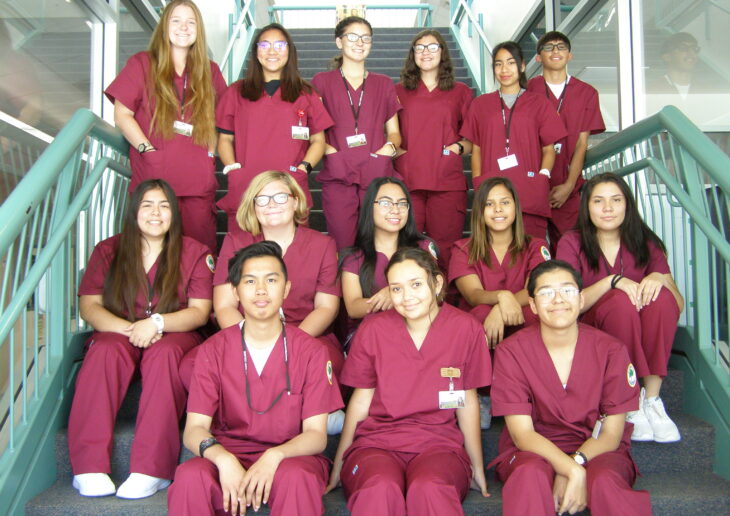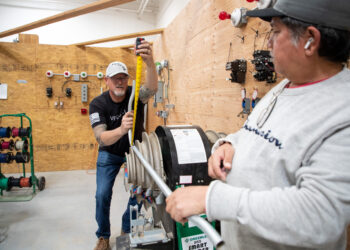
Culinary careers are sizzling again as the hospitality and restaurant industry bounces back from the pandemic and seeks to fill the positions vacated during the COVID-19 downturn. Chaffey College is doing its part to get more cooks in the kitchen.

Of all the tireless health care heroes keeping a busy hospital humming, nursing assistants are perhaps the most unsung. Now, thanks to a privately funded grant through Palo Verde College, at least they’ll be spoken for.
PVC’s prerequisite-free Certified Nursing Assistant (CNA) program has been launching nursing assistants into rewarding work for more than 20 years. This fall, the program will make those opportunities available to even more Californians with a new grant from the Arthur N. Rupe Foundation.
“The Rupe grant will make it possible for anyone wanting to become a nursing assistant an opportunity to do so at little or no cost,” says Dr. Theresa Becker, Associate Dean of Nursing & Allied Health at Palo Verde College.
The grant is a potential game-changer for CNA students, who typically cannot use financial aid to help pay for their studies. And it’s starting immediately: all 15 students in the upcoming cohort will be eligible to receive help covering tuition, fees, books and scrubs.
“Our community will benefit tremendously,” predicts Nursing Educational Advisor Celeste Velarde.
The new scholarship opportunity comes at a critical moment. Demand for nursing assistants in California is spiking, with opportunities expanding at nearly double the national average, according to the U.S. Bureau of Labor Statistics.In fact, due to the aging population, qualified nursing assistants are some of the most sought-after professionals in health care. Policy research group California Competes: Higher Education for a Strong Economy estimates that nearly 13,000 nursing assistant positions go unfilled every year in the state. Thus, it’s no surprise that California is one of the top-paying states in the nation while also boasting the most CNA jobs.
The perks to becoming a CNA go beyond rewarding work with patients. Nursing assistants enjoy abundant job opportunities and flexible schedules. Meanwhile, due to the shortage, they’re able to find jobs virtually anywhere with relative ease.
California is hoping to keep them home – particularly, in places like Blythe, where the need is critical.
“CNAs are in very high demand at our local nursing home and the two prisons located 20 miles west of town,” explains Becker.
Demand for essential professionals has sparked a need for creative thinking at PVC. This summer, the College will host a CNA program especially for high school students, who can become certified as young as 16. According to Velarde, a 17-year-old student from last summer’s program got hired right away: “That speaks to how big of a demand there is because of the pandemic.”
Learners master the art of care, from assisting patients with daily routines like bathing to promoting proper hygiene and taking vital signs. Students can also earn complementary certifications at the College, including phlebotomy, electrocardiography and first aid.
Through the program’s 20+ years, the College has graduated more than 800 nursing assistants, with more on the way. Besides boosting wages in the present, CNAs build valuable experience to apply toward a long-term career in health care.
“As a CNA, job opportunities are available that pay well above the minimum wage,” says Becker. “This allows nursing students to work as CNAs while in school at a decent wage.”
Indeed, becoming a CNA is often the first step to higher-level health care jobs. At Palo Verde College, the CNA program is a foundational requirement to become a Licensed Vocational Nurse (LVN).
“It’s really good for our vocational nurse students to take these courses right away,” says Velarde. “It allows students to get a feel for if they’re going to like it, and then you can also work while you’re completing the rest of your vocational nursing courses.”
It’s the kind of hands-on head start that gives students a professional boost… without the bill.
“The Rupe grant enables the student to enter the VN program with no outstanding student loans or debt related to becoming a CNA,” according to Becker.
Because the community is small and close-knit, the CNA program offers a unique connection to veteran nurses. “You’re getting to work alongside professors who have worked in this community for 20 to 30 years,” says Velarde. “Because of how much they care about the community, I think it really adds something to our CNA program.”
Just ask Katchya “Kat” Currier, a registered nurse at industry partner Blythe Post Acute medical center and nursing home, which hires about 10 to 15 CNA alums every year for the past twenty-plus years.
“We take a lot of the graduates that are looking for a stepping-stone,” says Currier. “Everyone that we’ve ever taken has usually been really good.”
Not only was Currier designated a Blythe “Health Care Hero” last May by the Palo Verde Valley Times, but she’s also a CNA program alum from the class of 1999. She has been at Blythe Post Acute ever since she graduated and estimates that she’s helped hire about 200 Palo Verde alums over her two-decade-plus tenure. In that time, the proud Pirate has taken pleasure watching her alma mater grow.
“I actually ended up going out to the College of the Desert to get my RN because it was not available at Palo Verde College,” recalls Currier, who is excited to see that all changing. Palo Verde College is currently working on its own RN program, which Currier says “is amazing because we can stay in town.” Because the area is remote – about 90 miles, or an hour and a half, from the nearest major city – she says that having a regional and robust educational pipeline is crucial.
Currier is thankful for the center’s close relationship with Palo Verde College and is especially grateful when students come to help out with vaccinations and testing. The new scholarships, she says, will be critical in helping more health care heroes join the ranks.
“With our low-income area, it’s really important that we do get the scholarships out to the kids who can benefit from them,” says the industry partner.
According to Currier, the partnership with the College is strengthening the region’s entire health care sector. It’s something she’s proud to be a part of:
“As a nurse, you want to be able to prepare the next generation,” she says.
“We probably would have no staff if it weren’t for the College continuously turning out great CNAs for us every year.”
Sources:
California Competes, Meeting California’s Demand for Allied Health Workers
https://californiacompetes.org/assets/general-files/CA-Competes-Allied-Health_Final.pdf
California Wages for Nursing Assistants
https://www.onetonline.org/link/localwages/31-1131.00?st=CA&g=Go
Occupational Employment and Wages, May 2020, Nursing Assistants
https://www.bls.gov/oes/current/oes311131.htm#st
2020 National Nurses Week: Amid COVID-19, Blythe highlights healthcare heroes

Culinary careers are sizzling again as the hospitality and restaurant industry bounces back from the pandemic and seeks to fill the positions vacated during the COVID-19 downturn. Chaffey College is doing its part to get more cooks in the kitchen.

Dual Enrollment (DE) is catching on as students and their families recognize the advantages of earning college credit while still working towards high school graduation. But students aren’t the only… Read More – Good News for Community Colleges: Dual Enrollments Are on the Rise

Enrollment in courses not offering credit toward a degree or certificate are outpacing for-credit programs in some states (Fed Communities). And it’s no wonder. With the convenience, minimal time commitment,… Read More – No Credit, No Problem: Noncredit Courses Gain Steam